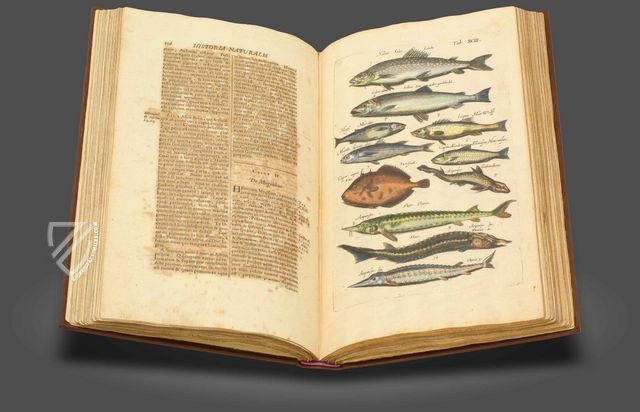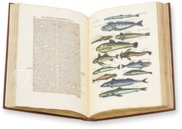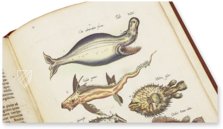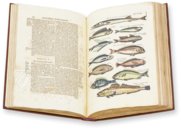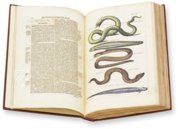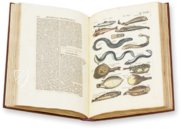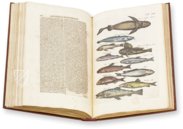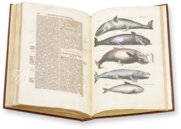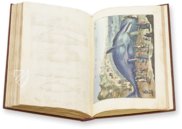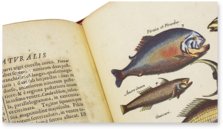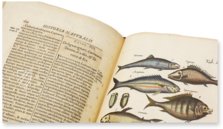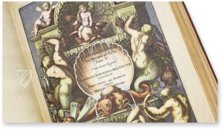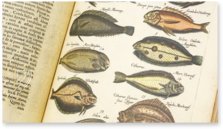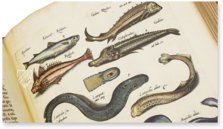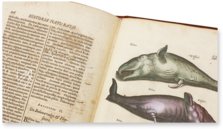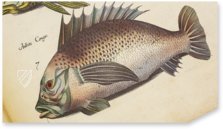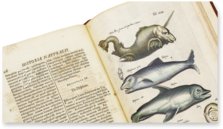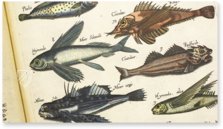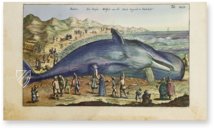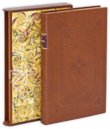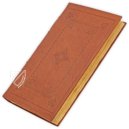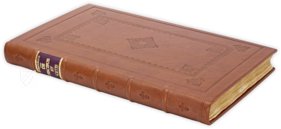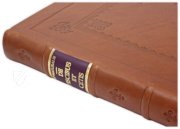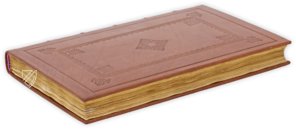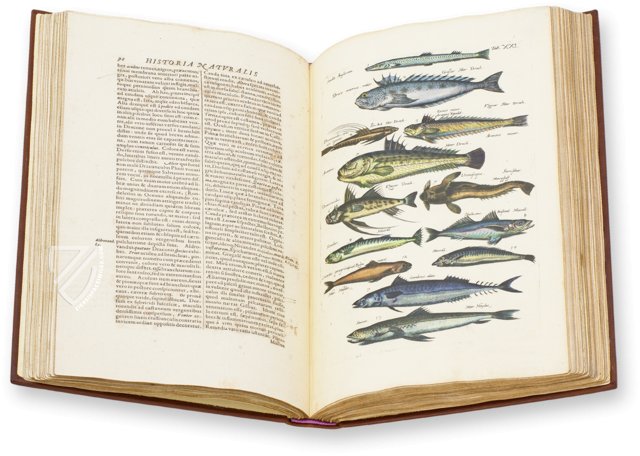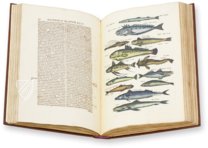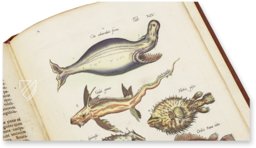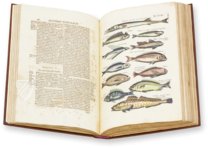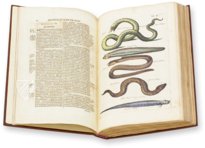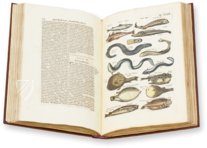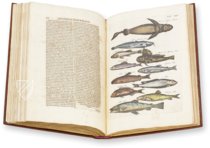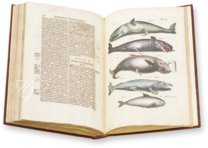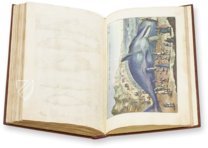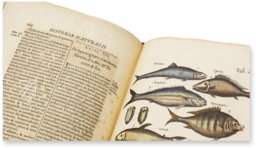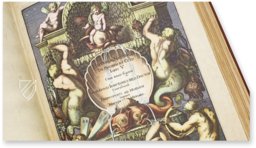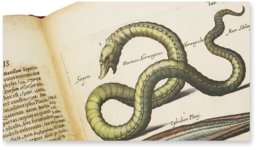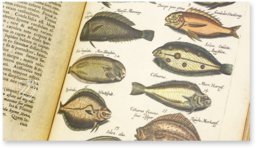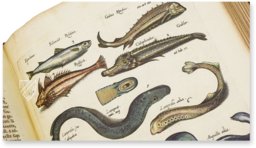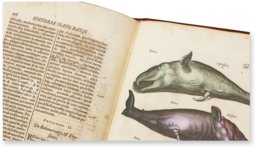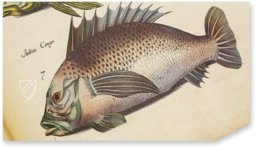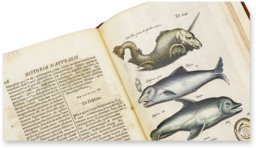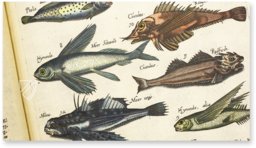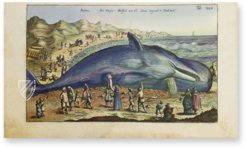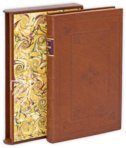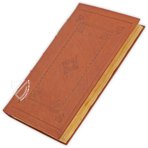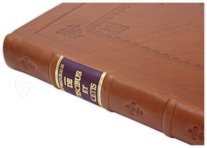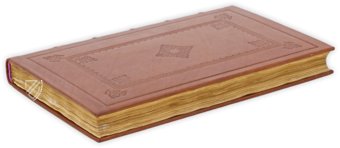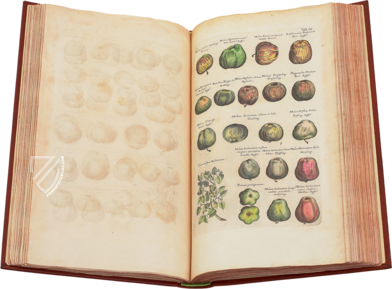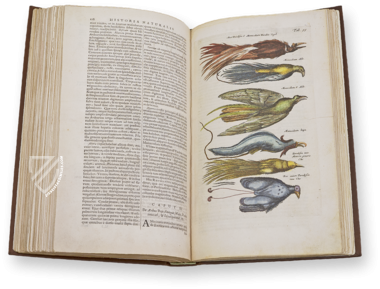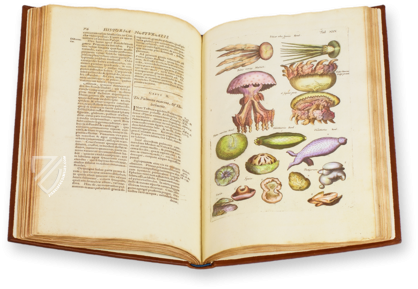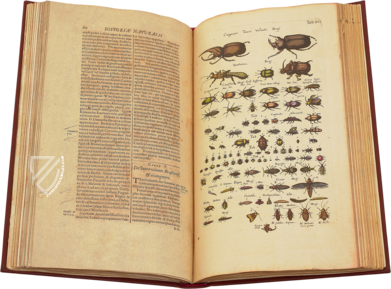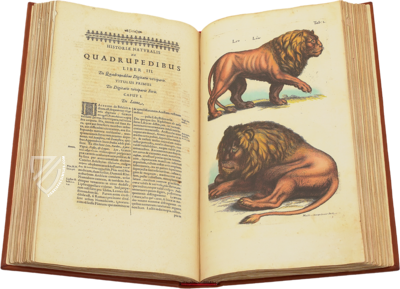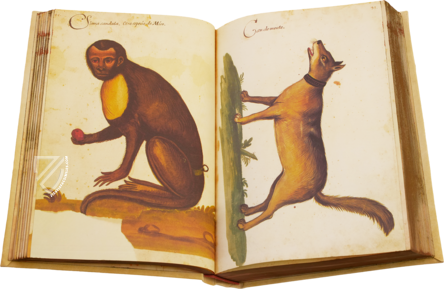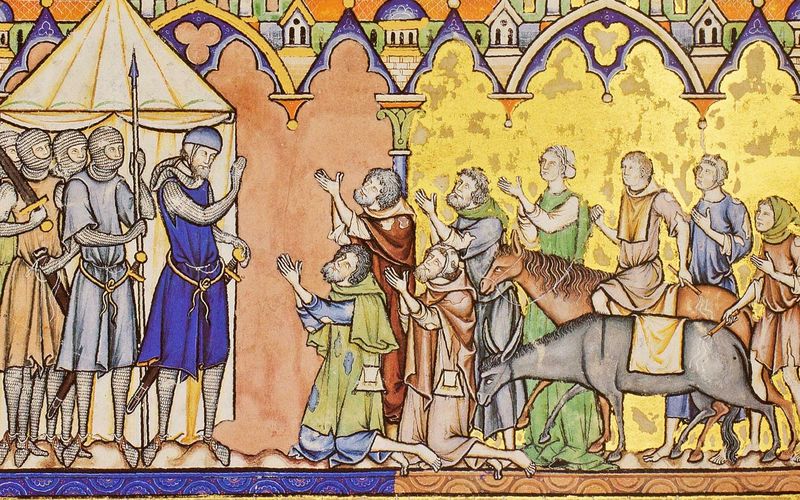Historia Naturalis: De Piscibus et Cetis
(3,000€ - 7,000€)
In the middle of the 16th century, the Polish doctor and Renaissance man John Jonston wrote an encyclopedic overview of the history of animals, which was considered to be the standard work of zoology for a century. His Historia naturalis animalium collects numerous descriptions of animals in five books. Tables with wonderful copperplate engravings by Matthäus Merian the Younger illustrate the zoological work. In the first volume of the work, which arose in the year 1650, Jonston concerns himself with fish and aquatic mammals. This “most broadly disseminated zoological handbook” experienced numerous republications and translations into other languages, still offering a magnificent and often curious glimpse into the world of zoology today.
Historia Naturalis: De Piscibus et Cetis
In the middle of the 16th century, the Polish doctor and Renaissance man John Jonston wrote an encyclopedic overview of the history of animals, which was considered to be the standard work of zoology for a century. His Historia naturalis animalium collects numerous descriptions of animals in five books. Tables with wonderful copperplate engravings by Matthäus Merian the Younger illustrate the zoological work. In the first volume of the work, which arose in the year 1650, Jonston concerns himself with fish and aquatic mammals. This “most broadly disseminated zoological handbook” experienced numerous republications and translations into other languages, still offering a magnificent and often curious glimpse into the world of zoology today.
Exotic Fish and Huge Whales
On 314 pages and with a total of 47 copperplate engravings, the first volume of John Jonston’s Historia Naturalis presents more than 500 fish and sea creatures. Subdivided into 5 chapters, e.g. saltwater fish, freshwater fish, fish that live in stony waters, fish that live closer to the shore, or exotic fish, the work offers a simultaneously scientific and entertaining overview. Alongside the pages of text with detailed descriptions, the pages with numerous depictions of a variety of fish are particularly amazing. The depicted animals are sometimes very curious. On one page, for example, Jonston also presents anthropomorphic figures with fishtails and human heads. One fish wears a horn on its forehead, another frightens with a savage mouth. One page is filled with the depiction of a huge, beached whale, which a group of people gaze at as an attraction. The last chapter of descriptions of fish is concerned with dolphins and aquatic mammals. Seals and walruses were also associated with fish – dolphins to be more precise.
The Renaissance Man John Jonston
As the first volume of the Historia naturalis animalium, the de piscibus etcetis contains a foreward with which Jonston introduces his magnum opus. This is dated in the year 1649. In the text, the author clarifies his motives and purposes and names his sources from ancient and contemporary authors. John Jonston (1603–1675) was the son of Scottish parents, a doctor, and a Renaissance man from Poland. Through tours and visits of study across all of Europe, John collected a general knowledge that encompassed a variety of disciplines, which he transmitted as a tutor and tour guide to young nobles. He was famous nevertheless through his scientific-pedagogical writings concerning such diverse topics as child-rearing, philosophy and theology, history, but also medicine and mineralogy, all before the famous Historia Naturalis.
Standard Work of Zoology
For his incomplete magnum opus, Jonston planned a comprehensive illustrated depiction of the world of animals, plants, and people. The Historia Naturalis animalium was printed from 1650 to 1653 in the publishing house of Matthäus Merian the Younger in Frankfurt am Main. Merian (1621–1687), who took over the famous atelier of his father Matthäus Merian the Elder, as copperplate engraver was also responsible for the artistic design of the editions. The marvelous illustrations, colorfully illustrated moreover, lend the sophisticated publication its final touches and are surely a reason for the exceptional popularity of the Historia Naturalis across Europe.
Codicology
- Size / Format
- 314 pages / 38.0 × 22.0 cm
- Origin
- Germany
- Date
- 1649
- Epochs
- Style
- Language
- Illustrations
- 47 copperplate engravings representing over 500 fishes and cetaceans
- Artist / School
- Johannes Jonstonus (John Jonston) (1603–1675) (author)
Matthaeus Merian The Younger (1621–1687) (engraver)
Historia Naturalis: De Exanguibus Acuaticis et Serpentibus
Anthias Fish
Here we see two specimens of a subfamily of colorful fishes known as Anthiadinae that are found among tropical reefs in the deeps virtually all oceans and seas across the world. Aside from their wonderful colors, which make them popular as ornamental fish, their complex social structures make them additionally fascinating. Both of the Latin names for these two fish are outdated and no longer in use, but the skillful coloring of the woodcuts is remarkably naturalistic.
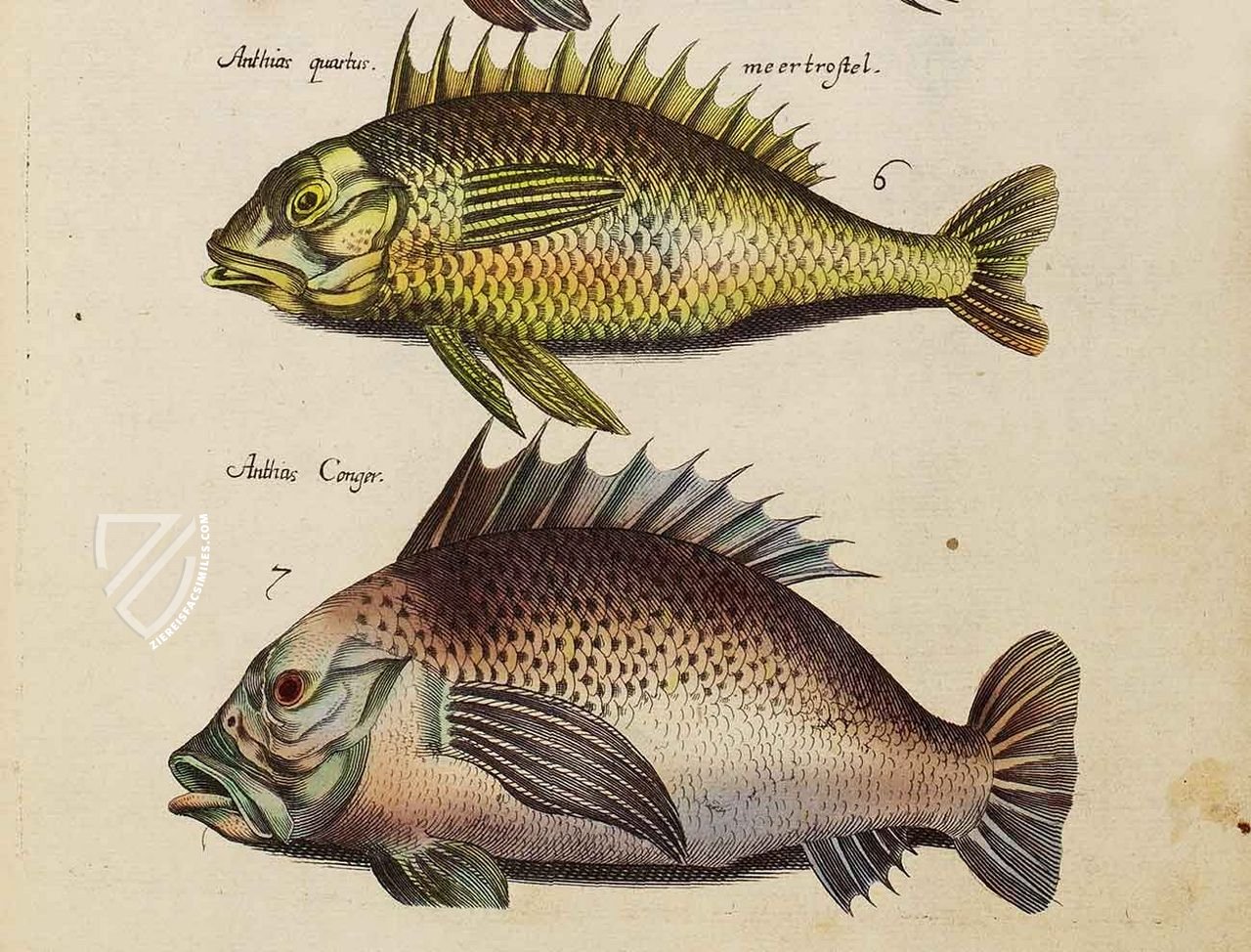
Historia Naturalis: De Piscibus et Cetis
Beached Whale
This fantastic woodcut of a beached whale is presented with a German caption reading: “Balaena. A large whale 60 shoes in length and 41 shoes in height”. Balanea is the genus of whale pictured here, the only extant species of which is the bowhead whale, an animal capable of living more than 200 years, giving them the most longevity of any mammal when they aren’t tragically beached.
The phenomenon of cetacean stranding, usually referred to as beaching, is still not fully understood, despite occurring since before the beginning of recorded history. As sad as it may be to see these majestic animals so helpless, such events provided early zoologists with a unique opportunity to observe these creatures in a manner that would otherwise be impossible.
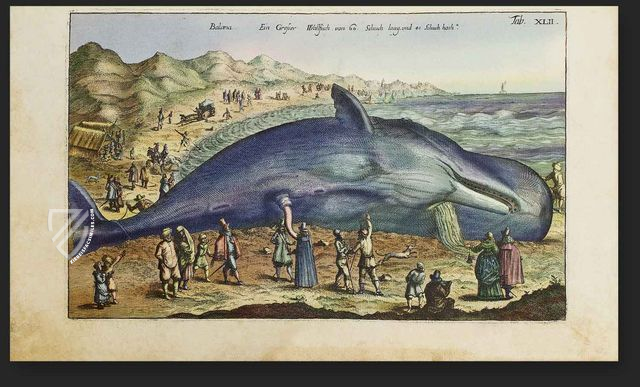
#1 Historia Naturalis: De Piscibus et Cetis
Language: Spanish
(3,000€ - 7,000€)
- Treatises / Secular Books
- Apocalypses / Beatus
- Astronomy / Astrology
- Bestiaries
- Bibles / Gospels
- Chronicles / History / Law
- Geography / Maps
- Saints' Lives
- Islam / Oriental
- Judaism / Hebrew
- Single Leaf Collections
- Leonardo da Vinci
- Literature / Poetry
- Liturgical Manuscripts
- Medicine / Botany / Alchemy
- Music
- Mythology / Prophecies
- Psalters
- Other Religious Books
- Games / Hunting
- Private Devotion Books
- Other Genres
- Afghanistan
- Armenia
- Austria
- Belgium
- Belize
- Bosnia and Herzegovina
- China
- Colombia
- Costa Rica
- Croatia
- Cyprus
- Czech Republic
- Denmark
- Egypt
- El Salvador
- Ethiopia
- France
- Germany
- Greece
- Guatemala
- Honduras
- Hungary
- India
- Iran
- Iraq
- Israel
- Italy
- Japan
- Jordan
- Kazakhstan
- Kyrgyzstan
- Lebanon
- Liechtenstein
- Luxembourg
- Mexico
- Morocco
- Netherlands
- Palestine
- Panama
- Peru
- Poland
- Portugal
- Romania
- Russia
- Serbia
- Spain
- Sri Lanka
- Sweden
- Switzerland
- Syria
- Tajikistan
- Turkey
- Turkmenistan
- Ukraine
- United Kingdom
- United States
- Uzbekistan
- Vatican City
- A. Oosthoek, van Holkema & Warendorf
- Aboca Museum
- Ajuntament de Valencia
- Akademie Verlag
- Akademische Druck- u. Verlagsanstalt (ADEVA)
- Aldo Ausilio Editore - Bottega d’Erasmo
- Alecto Historical Editions
- Alkuin Verlag
- Almqvist & Wiksell
- Amilcare Pizzi
- Andreas & Andreas Verlagsbuchhandlung
- Archa 90
- Archiv Verlag
- Archivi Edizioni
- Arnold Verlag
- ARS
- Ars Magna
- ArtCodex
- AyN Ediciones
- Azimuth Editions
- Badenia Verlag
- Bärenreiter-Verlag
- Belser Verlag
- Belser Verlag / WK Wertkontor
- Benziger Verlag
- Bernardinum Wydawnictwo
- BiblioGemma
- Biblioteca Apostolica Vaticana (Vaticanstadt, Vaticanstadt)
- Bibliotheca Palatina Faksimile Verlag
- Bibliotheca Rara
- Boydell & Brewer
- Bramante Edizioni
- Bredius Genootschap
- Brepols Publishers
- British Library
- C. Weckesser
- Caixa Catalunya
- Canesi
- CAPSA, Ars Scriptoria
- Caratzas Brothers, Publishers
- Carus Verlag
- Casamassima Libri
- Centrum Cartographie Verlag GmbH
- Chavane Verlag
- Christian Brandstätter Verlag
- Circulo Cientifico
- Club Bibliófilo Versol
- Club du Livre
- CM Editores
- Collegium Graphicum
- Collezione Apocrifa Da Vinci
- Comissão Nacional para as Comemorações dos Descobrimentos Portugueses
- Coron Verlag
- Corvina
- CTHS
- D. S. Brewer
- Damon
- De Agostini/UTET
- De Nederlandsche Boekhandel
- De Schutter
- Deuschle & Stemmle
- Deutscher Verlag für Kunstwissenschaft
- DIAMM
- Droz
- E. Schreiber Graphische Kunstanstalten
- Ediciones Boreal
- Ediciones Grial
- Ediclube
- Edições Inapa
- Edilan
- Editalia
- Edition Deuschle
- Edition Georg Popp
- Edition Leipzig
- Edition Libri Illustri
- Editiones Reales Sitios S. L.
- Éditions de l'Oiseau Lyre
- Editions Medicina Rara
- Editorial Casariego
- Editorial Mintzoa
- Editrice Antenore
- Editrice Velar
- Edizioni Edison
- Egeria, S.L.
- Eikon Editores
- Electa
- Emery Walker Limited
- Enciclopèdia Catalana
- Eos-Verlag
- Ephesus Publishing
- Ernst Battenberg
- Eugrammia Press
- Extraordinary Editions
- Fackelverlag
- Facsimila Art & Edition
- Facsimile Editions Ltd.
- Facsimilia Art & Edition Ebert KG
- Faksimile Verlag
- Feuermann Verlag
- Folger Shakespeare Library
- Franco Cosimo Panini Editore
- Friedrich Wittig Verlag
- Fundación Hullera Vasco-Leonesa
- G. Braziller
- Gabriele Mazzotta Editore
- Gebr. Mann Verlag
- Gesellschaft für graphische Industrie
- Getty Research Institute
- Giovanni Domenico de Rossi
- Giunti Editore
- Graffiti
- Grafica European Center of Fine Arts
- Guido Pressler
- Guillermo Blazquez
- Gustav Kiepenheuer
- H. N. Abrams
- Harrassowitz
- Harvard University Press
- Helikon
- Hendrickson Publishers
- Henning Oppermann
- Herder Verlag
- Hes & De Graaf Publishers
- Hoepli
- Holbein-Verlag
- Houghton Library
- Hugo Schmidt Verlag
- Idion Verlag
- Il Bulino, edizioni d'arte
- ILte
- Imago
- Insel Verlag
- Insel-Verlag Anton Kippenberger
- Instituto de Estudios Altoaragoneses
- Instituto Nacional de Antropología e Historia
- Introligatornia Budnik Jerzy
- Istituto dell'Enciclopedia Italiana - Treccani
- Istituto Ellenico di Studi Bizantini e Postbizantini
- Istituto Geografico De Agostini
- Istituto Poligrafico e Zecca dello Stato
- Italarte Art Establishments
- Jan Thorbecke Verlag
- Johnson Reprint Corporation
- Josef Stocker
- Josef Stocker-Schmid
- Jugoslavija
- Karl W. Hiersemann
- Kasper Straube
- Kaydeda Ediciones
- Kindler Verlag / Coron Verlag
- Kodansha International Ltd.
- Konrad Kölbl Verlag
- Kurt Wolff Verlag
- La Liberia dello Stato
- La Linea Editrice
- La Meta Editore
- Lambert Schneider
- Landeskreditbank Baden-Württemberg
- Leo S. Olschki
- Les Incunables
- Liber Artis
- Library of Congress
- Libreria Musicale Italiana
- Lichtdruck
- Lito Immagine Editore
- Lumen Artis
- Lund Humphries
- M. Moleiro Editor
- Maison des Sciences de l'homme et de la société de Poitiers
- Manuscriptum
- Martinus Nijhoff
- Maruzen-Yushodo Co. Ltd.
- MASA
- Massada Publishers
- McGraw-Hill
- Metropolitan Museum of Art
- Militos
- Millennium Liber
- Müller & Schindler
- Nahar - Stavit
- Nahar and Steimatzky
- National Library of Wales
- Neri Pozza
- Nova Charta
- Oceanum Verlag
- Odeon
- Orbis Mediaevalis
- Orbis Pictus
- Österreichische Staatsdruckerei
- Oxford University Press
- Pageant Books
- Parzellers Buchverlag
- Patrimonio Ediciones
- Pattloch Verlag
- PIAF
- Pieper Verlag
- Plon-Nourrit et cie
- Poligrafiche Bolis
- Presses Universitaires de Strasbourg
- Prestel Verlag
- Princeton University Press
- Prisma Verlag
- Priuli & Verlucca, editori
- Pro Sport Verlag
- Propyläen Verlag
- Pytheas Books
- Quaternio Verlag Luzern
- Reales Sitios
- Recht-Verlag
- Reichert Verlag
- Reichsdruckerei
- Reprint Verlag
- Riehn & Reusch
- Roberto Vattori Editore
- Rosenkilde and Bagger
- Roxburghe Club
- Salerno Editrice
- Saltellus Press
- Sandoz
- Sarajevo Svjetlost
- Schöck ArtPrint Kft.
- Schulsinger Brothers
- Scolar Press
- Scrinium
- Scripta Maneant
- Scriptorium
- Shazar
- Siloé, arte y bibliofilia
- SISMEL - Edizioni del Galluzzo
- Sociedad Mexicana de Antropología
- Société des Bibliophiles & Iconophiles de Belgique
- Soncin Publishing
- Sorli Ediciones
- Stainer and Bell
- Studer
- Styria Verlag
- Sumptibus Pragopress
- Szegedi Tudomànyegyetem
- Taberna Libraria
- Tarshish Books
- Taschen
- Tempus Libri
- Testimonio Compañía Editorial
- Thames and Hudson
- The Clear Vue Publishing Partnership Limited
- The Facsimile Codex
- The Folio Society
- The Marquess of Normanby
- The Richard III and Yorkist History Trust
- Tip.Le.Co
- TouchArt
- TREC Publishing House
- TRI Publishing Co.
- Trident Editore
- Tuliba Collection
- Typis Regiae Officinae Polygraphicae
- Union Verlag Berlin
- Universidad de Granada
- University of California Press
- University of Chicago Press
- Urs Graf
- Vallecchi
- Van Wijnen
- VCH, Acta Humaniora
- VDI Verlag
- VEB Deutscher Verlag für Musik
- Verlag Anton Pustet / Andreas Verlag
- Verlag Bibliophile Drucke Josef Stocker
- Verlag der Münchner Drucke
- Verlag für Regionalgeschichte
- Verlag Styria
- Vicent Garcia Editores
- W. Turnowski Ltd.
- W. Turnowsky
- Waanders Printers
- Wiener Mechitharisten-Congregation (Wien, Österreich)
- Wissenschaftliche Buchgesellschaft
- Wissenschaftliche Verlagsgesellschaft
- Wydawnictwo Dolnoslaskie
- Xuntanza Editorial
- Zakład Narodowy
- Zollikofer AG

